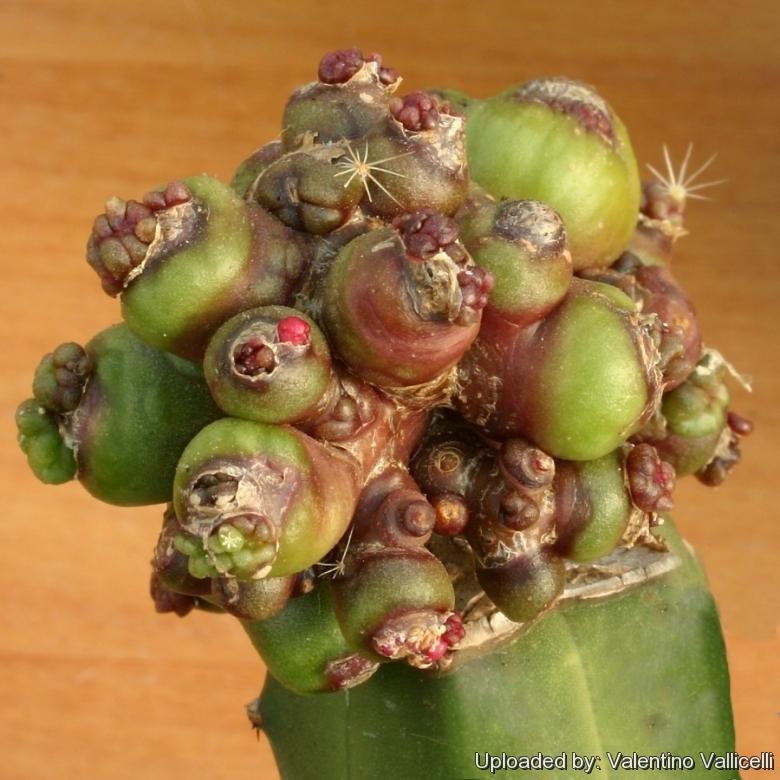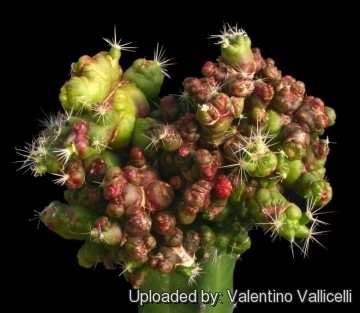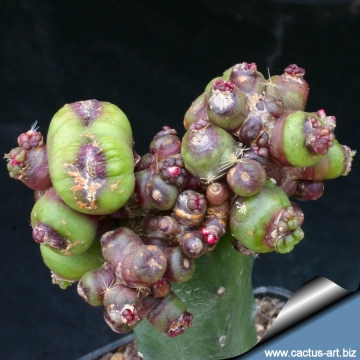
Mammillaria bombycina f. monstruosa green clone Photo by: Valentino Vallicelli
Origin and Habitat: Garden origin (Nursery produced cultivar)
Synonyms:
See all synonyms of Mammillaria bombycina
Description: This is a strange monstrous cactus cultivar that forms very rubbery and squishy green and purple glob. It is supposed to be a mutation that formed on a normal {{Mammillaria bocasanaSN|8970]]SN|8970]]}}, but its true self is controversial. This cultivar shows many growing variations, with different monstrous shapes. The plant looks more like some non-cactus succulent than a cactus. Rarely a spine or a hair. It may enlarge to form low, massive clusteres.
Stem: Smooth, lumpy, rubbery-textured (much like a tumour), subtly crested, green and pink only a few centimetres across.
Subspecies, varieties, forms and cultivars of plants belonging to the Mammillaria bombycina group
 Mammillaria bombycina Quehl: Solitary or clustering cactus, some clones cluster aggressively and can form 50-90 cm wide mounds. It combines clean, glassy white radial spines with hooked reddish-brown centrals.This plant will produce several complete circles of contrasting light carmine flowers.
Mammillaria bombycina Quehl: Solitary or clustering cactus, some clones cluster aggressively and can form 50-90 cm wide mounds. It combines clean, glassy white radial spines with hooked reddish-brown centrals.This plant will produce several complete circles of contrasting light carmine flowers.- Mammillaria bombycina f. albicentralis hort.: Has evenly white or creamy-white hooked central spines, (tips never reddish-brown). Cultivated form.
 Mammillaria bombycina f. flavispina hort.: Has evenly creamy-yellow or yellow hooked central spines, (tips never reddish-brown). Cultivated form.
Mammillaria bombycina f. flavispina hort.: Has evenly creamy-yellow or yellow hooked central spines, (tips never reddish-brown). Cultivated form. Mammillaria bombycina f. monstruosa green clone hort.: It is a strange monstrous cactus cultivar that forms very rubbery and squishy green and purple glob.
Mammillaria bombycina f. monstruosa green clone hort.: It is a strange monstrous cactus cultivar that forms very rubbery and squishy green and purple glob. Mammillaria bombycina f. monstruosa white clone hort.: It cluster aggressively and forms a gorgeous white mounds with a fluffy appearance.
Mammillaria bombycina f. monstruosa white clone hort.: It cluster aggressively and forms a gorgeous white mounds with a fluffy appearance. Mammillaria bombycina cv. Split Spine: This very rare cultivar has unique "Split spines". This is an exclusive feature never seen in other cacti.
Mammillaria bombycina cv. Split Spine: This very rare cultivar has unique "Split spines". This is an exclusive feature never seen in other cacti. Mammillaria perezdelarosae Bravo & Scheinvar: Differs from Mammillaria bombycina in its darker centrals and denser, pectinately arranged radials that completely conceal the epidermis, and in its paler pink flowers.
Mammillaria perezdelarosae Bravo & Scheinvar: Differs from Mammillaria bombycina in its darker centrals and denser, pectinately arranged radials that completely conceal the epidermis, and in its paler pink flowers. Mammillaria perezdelarosae subs. andersoniana W.A.Fitz Maur. & B.Fitz Maur.: distinguishable for the smaller size, slower growth and straight central spines (not hooked). It is believed to be one of the most beautiful Mammillaria. Distribution: Northeast, Zacatecas, Municipio Via Garcia
Mammillaria perezdelarosae subs. andersoniana W.A.Fitz Maur. & B.Fitz Maur.: distinguishable for the smaller size, slower growth and straight central spines (not hooked). It is believed to be one of the most beautiful Mammillaria. Distribution: Northeast, Zacatecas, Municipio Via Garcia Mammillaria perezdelarosae f. cristata hort.: crested form with stems densely covered with glassy white radial spines with hooked dark-brown centrals. It is one of the more beautiful crested Mammillaria.
Mammillaria perezdelarosae f. cristata hort.: crested form with stems densely covered with glassy white radial spines with hooked dark-brown centrals. It is one of the more beautiful crested Mammillaria.
 Mammillaria bombycina f. monstruosa green clone Photo by: Valentino Vallicelli
Mammillaria bombycina f. monstruosa green clone Photo by: Valentino Vallicelli Mammillaria bombycina f. monstruosa green clone Photo by: Cactus Art
Mammillaria bombycina f. monstruosa green clone Photo by: Cactus ArtCultivation and Propagation: Keep well ventilated, as it is prone to root rot. Protect from frosts and freezes. Hates the full sun in summer. It can thrive for years, but tend to self destruct, especially when it really odd looking. As with most monstrous, it began to die at the base (root rot is common); instead of giving up on it, you can cut it apart, let it heal and start many plants from that one.
Propagation: Grafting or Cuttings. It is easy to separate the "blog" into many new pieces. Each piece can be started on its own, with a bit of care, patience and maybe a little luck. As with most cactus, you can cut a piece, let it dry for a week or so, and put it into the soil and it will grow new roots, if the conditions are just right. The best luck is with cuttings that are 3 cm or larger; smaller ones will root, but they take much more effort to keep them alive.












